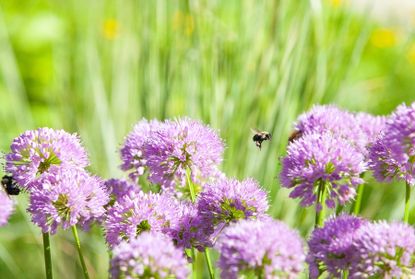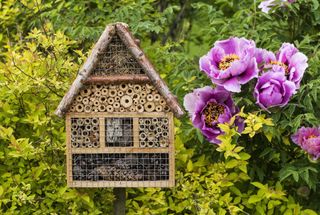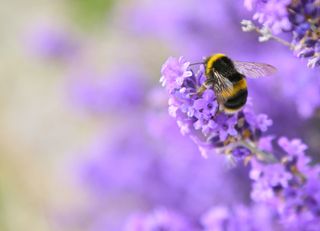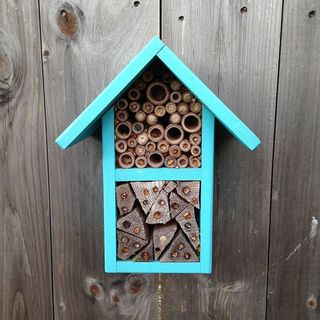How to attract bees and butterflies into your garden
Easy ways you and your kids can encourage bees and butterflies into your garden.

Easy ways you and your kids can encourage bees and butterflies into your garden.
Planting colourful, nectar-rich flowers is the best way to attract bees and butterflies, which will pollinate plants and help your garden grow. The sugar-rich nectar is a valuable source of nutrients for bees and butterflies, so create a tasty nectar bar to feed and shelter them. You can do this in a bed or border, or simply a window box or container.
Not only are pollinators essential for our ecosystem and the success of our crops, but it’s a pleasure to watch insects and birds in the garden.
Plus, you’ll have a colourful, aromatic display that brims with life.
Herbs that attract bees and insects
Include herbs in your nectar bar, for an aromatic boost and a chance to harvest fresh produce for your kitchen.
Nectar-rich lavender, rosemary and thyme will stimulate your senses with their strong fragrances. They also promote bee health, as they contain chemicals that can combat pests and viruses in the hive.
For aromatic plants that have masses of vibrant flowers, try sage and the gorgeous bee magnet, bergamot. Both these herbs make good tea infusions.
GoodtoKnow Newsletter
Parenting advice, hot topics, best buys and family finance tips delivered straight to your inbox.
Fennel will add height and interest, while also encouraging hoverflies. The seeds will be a good source of food for birds later in the year.

Best flowers for nectar for bees
Pollinators need nectar-rich, insect-friendly blooms. Simple flowers with easy access are ideal. Try cosmos, poppies and single dahlias, which are easily grown from seed. Butterflies love dahlias!
They also love native-flowering plants, such as heathers, thistles and hardy geraniums.
Purple is the colour bees see the clearest, so try the dramatic Verbena bonariensis, classy alliums and stately agapanthus.
Include tubular flowers, such as foxgloves, penstemons and snapdragons, for the long-tongued bumblebees.
Best plants for bees and butterflies
Upgrade your buffet to a feast with a towering buddleia – it’s easy to grow, with masses of purple flowers, adored by bees and butterflies.
If you live in a mild part of the country, try Echium pininana. A member of the borage family, this large and impressive plant has panicles four metres long with funnel-shaped blue flowers. Children will love watching the comings and goings as bees buzz and buttterflies flutter around this plant.

How to make your garden bee-friendly
- Bees often have to travel long distances to find nectar, so provide pit stops for weary bees. This could be a brick with holes in it, or a shop-bought bee hotel, like the one pictured above.
- Don’t use pesticides. Healthy plants, given conditions they can thrive in, will withstand pests better.
- Bees need water to drink – a shallow dish with pebbles in, filled with rainwater, is ideal.
10 ways to help your child can be a bee buddy
Your child will love being a bee buddy, say the honey people at Rowse. Bees are incredibly important because they pollinate plants. It’s thanks to pollinators, we have flowers, fruit and vegetables. Most of our UK bees are solitary bees but, as their name suggests, only honey bees give us honey.
But these busy little insects are in trouble, and their numbers are in decline globally. One way we can help bees is by becoming a bee buddy. Children, especially, will love the idea of being a pal to these amazing insects.
1) Because they feed on nectar, you can help bees by growing a variety of bee-friendly plants. Having flowers from early spring through to winter means they won’t go hungry. They’ll love hardy geraniums, cosmos, dahlias and penstemon.
2) Some plants are more effective than others at attracting bees, so grow flowers with single blooms (rather than doubles) as bees can get to the nectar more easily.

3) Bees especially like purple, so lavender and tall, airy verbena bonariensis are ideal to plant now. Children can plant them in a container or in a sunny spot in the garden, then get up close and watch as the bees get to work.
4) Bees don’t like having to fly too far, so position different varieties of plants close together.
5) Your child can plant herbs to help bees – borage, marjoram, rosemary and sage all attract bees.
6) You don’t have to have a garden to be a bee buddy. Children can nurture bee-friendly plants in a pot, window boxes and hanging baskets.
7) Bees love weeds! Clover and dandelions are bee magnets, so let your child mark out a patch of your lawn with bamboo canes and string. Let it grow wild – or raise the cutting blade on your mower a few centimetres.

8) Buy or make a bee hotel for solitary bees. It could be an apartment in a bug hotel.
9) Bees need water, so make sure there is somewhere for them to drink from. Children can top up a small bowl or saucer.
10) If you see a struggling bee, encourage your child to give it a one-off boost with some sugary water. Mix two tablespoons of white sugar and one tablespoon of water, put some of the mixture on a spoon with the bee and it should have a drink and revive!
-
 20 trendiest toys for outdoor fun this summer have been revealed, and #1 is a playground classic
20 trendiest toys for outdoor fun this summer have been revealed, and #1 is a playground classicNew analysis has found the trendiest toys for outdoor play this summer, including sporting favourites and more gentle pursuits
By Sarah Handley Published
-
 Why do babies need to lie flat in a pram?
Why do babies need to lie flat in a pram?Wondering why babies need to lie flat? Experts reveal all — plus whether or not a baby should sleep in a pram
By Charlotte Duck Published